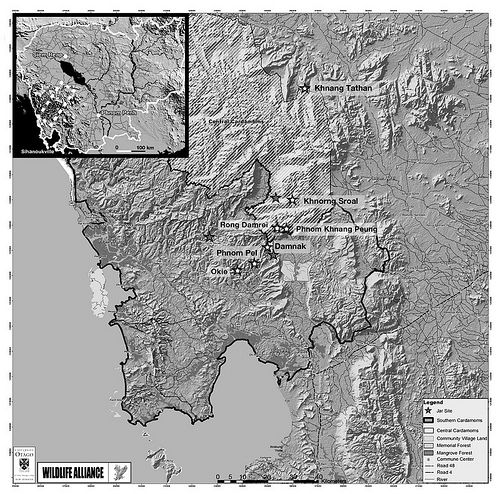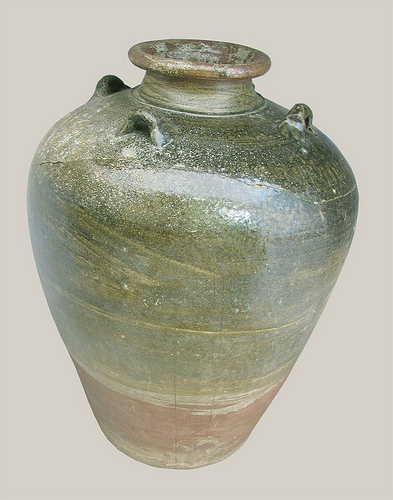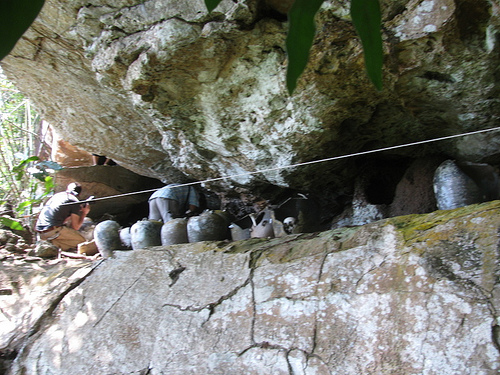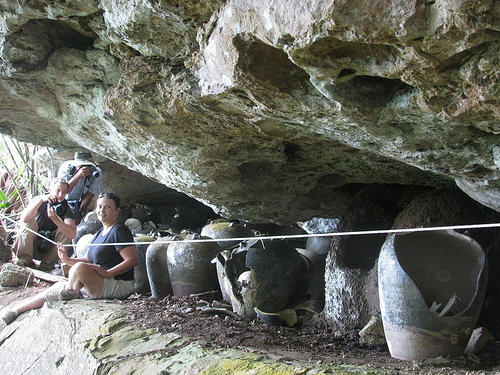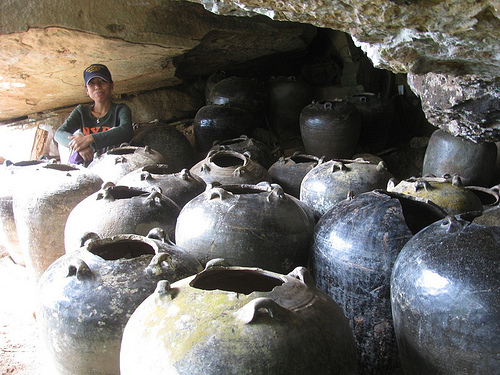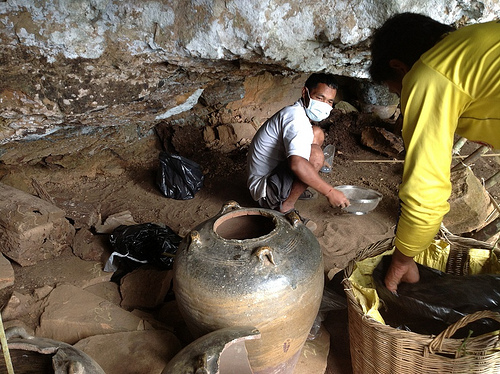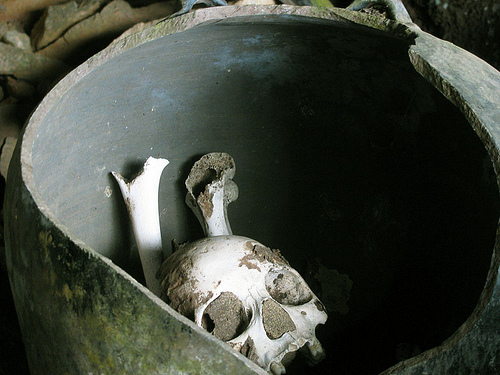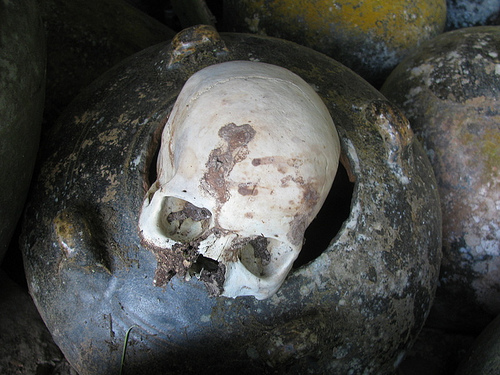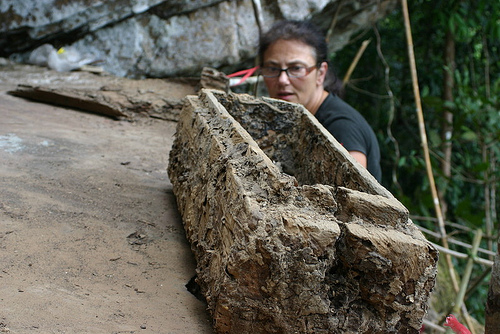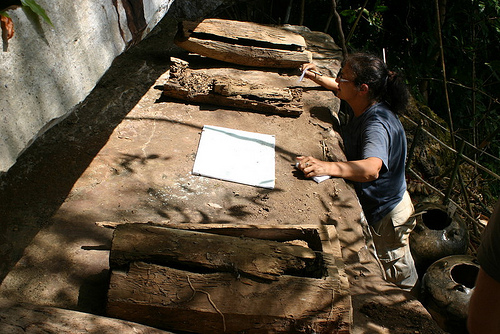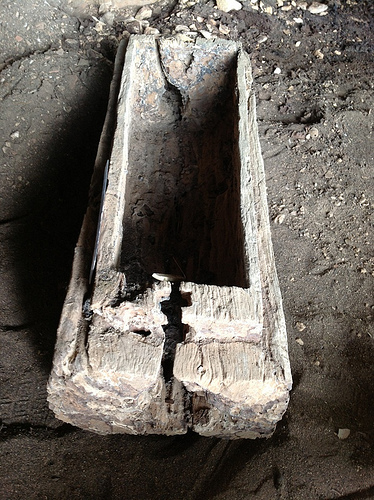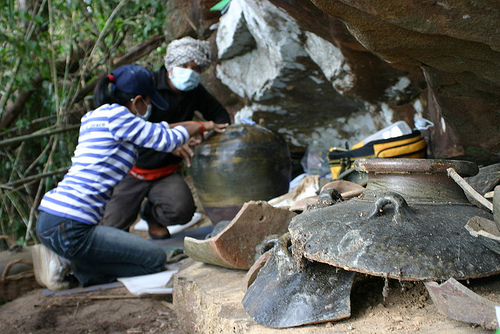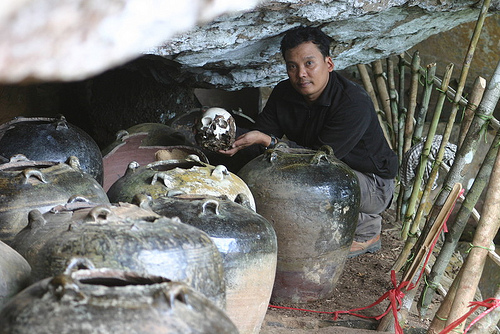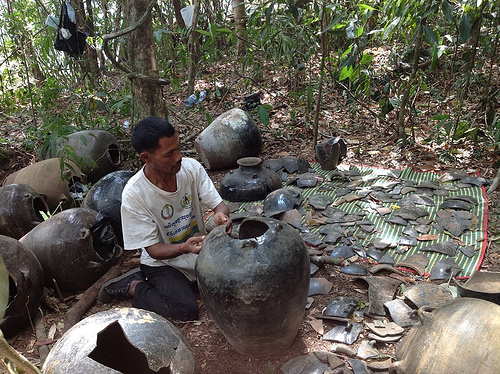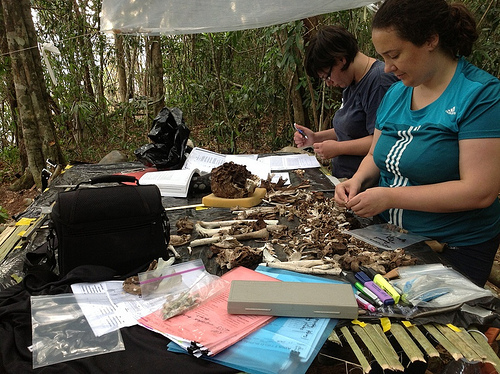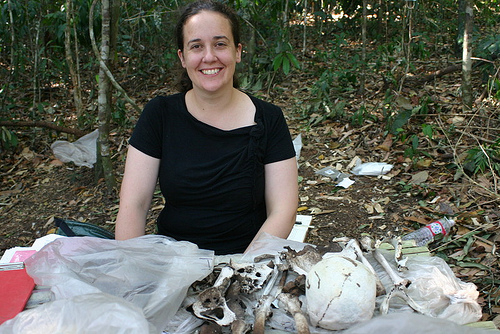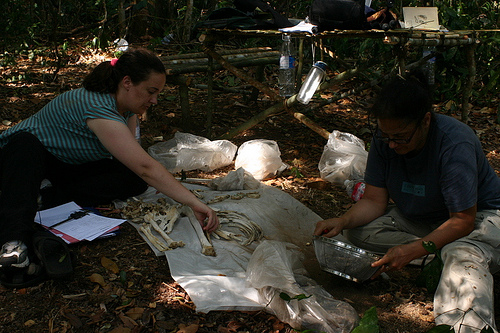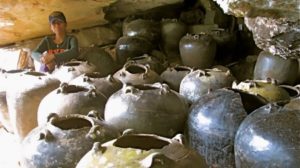
Lying beside the Phipot River about four hours drive from the Cambodian capital of Phnom Penh, the quiet community of Chi Phat goes about life much like many other villages and communities in the Cambodian countryside. These people are mostly farmers, growing rice, bananas and other crops, and fishermen. But a large number of village families also participate in the Chi Phat Community-Based Ecotourism (CBET) project, established about ten years ago with the help of a conservation organization. The ecotourism business offers a range of activities for those tourists who want the more unconventional experience of off-the-beaten-path activity and trekking — like morning bird-watching trips on the river, crab hunting at night, tree-planting, and trekking in the jungle. For those with special interests, such as archaeologists interested in the human past and things ancient, Chi Phat offers a special attraction – a chance to view the remains of a unique, ancient, mortuary ritual of a people still shrouded in mystery.
To see this, it often takes a journey on the back of a motorcycle along a trail so narrow that overhanging vegetation will scratch unprotected legs. The trail is at times so muddy that the rider must dismount to walk through leech-infested terrain, across fast-moving streams and slippery rocks, through clouds of butterflies, and near unsuspecting snakes. The trekker finally reaches a small clearing, to climb the rest of the way up a mountain to a wooden ladder. Here one encounters three high rock ledges. To explore the largest of them requires carefully crawling on hands and knees along a rock surface with a low ceiling above, inches away from the edge, a fall from which would surely mean an unsupported climber’s injury, if not death. Along the rock ledge surface are chipped stoneware jars containing bones, and what appear to be skillfully but simply crafted small wooden coffins with wooden lids. The bones within the jars are human. It is an ancient burial site.
Archaeologists have interpreted it as a secondary burial ritual mortuary site, one among 10 similar known sites distributed over 100 kilometers of the eastern ranges of Cambodia’s Cardamom Mountains jungle environment. Secondary burials have been practiced by a variety of cultures throughout history. They are often described as rites in which the bones of the deceased are placed in urns, bone boxes, or other vessels after the flesh has been stripped from the bones by natural decomposition. This particular secondary burial site, known as Phnom Pel, is the closest one to Chi Phat, and it, along with several other such sites, have been the objects of intensive study by Dr. Nancy Beavan and a team of associates. Beavan is an expert in radiocarbon dating, based at the University of Otago in New Zealand. She has examined and dated bones from a multitude of burial sites across the globe, but there was something unique and compelling about the Phnom Pel finds and those of the other nine sites. Beavan has made it her mission to find answers.
__________________________________________________________________________________________
Map of Cambodia and the Cardamom Mountains region. Stars mark all 10 sites that have been geo-located during the project work. The distance between the southernmost and northernmost sites is about 72 km. Map from Beavan, et al., 2012
_______________________________________________________________________________________________________________________
“I got a call from the documentary film-makers for National Geographic’s “Riddles of the Dead”[in 2003],” said Beavan, “who asked me if I could date a bone in 3 weeks. After I started to prepare the bone, I became rather curious because it looked so fresh. I got back in touch with them and they told me it was from Cambodia and from a burial site.”* The dating of the bone placed it during the time of the demise of the Khmer Empire in the mid-fifteenth century CE. That was the civilization that built the iconic temple structures of Angkor.
“I became absolutely fascinated”, she said.*
That fascination drove Beavan to investigate the original context of the bone, a journey that eventually led to a full-scale study now financed under a $720,000 grant from the Royal Society of New Zealand Marsden Fund.
It hasn’t been an easy journey.
The site where the bone was found is known as Khnorng Sroal, a Cardamom Mountains site located high on a south-facing natural rock ledge. And like Phnom Pel and the other sites, access for extended study requires some extraordinary measures. Motorcycles must be used to negotiate narrow trails, rivers must be crossed, long hikes are required on rugged terrain. And then there is the climbing, as the sites are located on elevated rock ledges. “Instead of going to these places and collecting everything to take back to a comfy lab to work on,” says Beavan, “we live in the jungle for weeks at a time eating dried fish and dried sausages and rice, using this time to do all of our data collection in the field, and taking only tiny samples for scientific analysis, so that we can conserve and protect the sites in their original state.” At another site known as Phnom Khang Peung, 600 meters above seal level and deep in the jungle, they had to use a helicopter to bring in enough water and provisions, including people, to stay for two weeks of field work. “And helicopters are not cheap,” Beavan exclaims, “so that straightforward solution has only been used once!”
Two central questions have underpinned Beavan’s entire effort: Who were these people? And why did they “bury” their dead this way?
Out From Oblivion
For obvious reasons, much of the archaeology and research on ancient Cambodia has focused on the more visible and spectacular sites of the Khmer Empire, arguably Southeast Asia’s greatest ancient civilization, whose temple builders dotted the landscape with wonders like Angkor Wat and Angkor Thom. Flourishing from the ninth to fifteenth centuries CE, it dominated the region economically, culturally, and politically. Indeed, chronological and historical referencing in both popular literature and academic studies in the broader examination of Southeast Asia’s past have usually anchored around ‘before’, ‘during’ or ‘after’ Angkor.
But there is something apart, unique and tantalizingly mysterious about these Cardamom Mountains rock ledge burials when compared to the better-known discoveries associated with Angkor. Beavan thinks they could tell a story of a forgotten highland people with a unique culture living on the margins of the Angkorian world during its waning days in the fifteenth century, and then long after it’s fall. She also suggests that, though their time overlapped with that of the end of Angkor, the mountain culture that created this funeral ritual was separate and distinct from Angkor.
The first clue to this evolving story has to do with location. “The rugged terrain and isolation of the region has given it notoriety over the centuries as a place of refuge. The mountains have also been home to ethnic minorities who notably lived apart from the Khmer culture of the lowlands and were seen as “savages” and taken as slaves in Angkorian times,” writes Beavan and colleagues in an international publication in 2012. **
The second clue relates to the nature and unique combination of characteristics of the finds. Those sites, which Beavan has radiocarbon dated to between CE 1395 to 1650 using wood, tooth enamel and human bone samples from four sites, feature ritual use of 53 cm high stoneware storage jars containing human bones, and small coffins (averaging only about 1 meter in length), each much too small to accommodate a flesh and blood adult. The jars and coffins were placed together high on rock ledges or overhangs. The 50-53-cm-high stoneware jars used for the burials are known as Maenam Noi jars, made at the Maenam Noi kilns in the Singburi province along the Chao Phraya River in Thailand. These jars were in production from about the fourteenth to possibly the sixteenth centuries CE. The kilns are hundreds of miles distant from the region of the Cardamom sites. Says Beavan:
“There are at least 75 of these large storage jars among the 10 sites that we have located, and let me tell you, getting these things up into their mountain burial sites must have been a mission and a half. But they did, and they were very particular, too: only a certain type of storage jar, and then after having procured them and hauled them by some still unknown means into their mountain homelands, they used them simply to contain the bones of their dead, filling the jars with one or more skeletons.”
(Above right, a typical Maenam Noi stoneware jar used to contain the bones of the dead. Credit Tep Sokha).
__________________________________________________________________________________________
The secondary burial jars and coffins were placed high on rock ledges in the Cardamom Mountains. Photo Credit Tep Sokha
________________________________________________________________________________________________________________________
Dr. Nancy Beavan sitting among the artifacts on the Phnom Khnang Peung site ledge. Photo Credit Ouk Sokha
________________________________________________________________________________________________________________________
A perspective view of the jars on a site rock ledge. Sitting in the background is Danni Eam, a member of the field team. Photo Credit Ouk Sokha
________________________________________________________________________________________________________________________
Mr. Gan, a long-time member of the team and a member of the Chong ethnic minority, sieves sediments on the jar ledge for artifacts. Photo Credit Ouk Sokha
_______________________________________________________________________________________________________________________
And there is much more. Writes Beavan in the 2012 report:
“All of the burial jars appear to have been prepared by breaking away the rim to facilitate the emplacement of larger skeletal material such as entire skulls. A hole was drilled through the bottom of each jar, perhaps to ritually “kill” the vessel. The log coffins in the Phnom Pel, Damnak Samdech, and Khang Tathan sites are made of an as yet unidentified tree species, which is extremely dense and has a fine annual growth structure. The coffins vary in overall length between 90 to 178 cm, but their design is generally similar in that whole logs are cut into sections, the centers are carved out in squared corners, and each is topped by a lid, but there is no additional carving or decoration to the exterior. The exception to this, at one of the oldest sites, Khnang Tathan, is a single coffin of 210 cm, which has deep chevron carving on the ends of the coffin lid.”**
In addition, the jars were found to contain green, yellow and blue glass beads, and simple bronze rings. The assemblages in all 10 sites also contained additional tradeware jars, bowls, and dishes, possibly used, according to the archaeological interpretation, for food offerings. Curiously, at every site Beavan and her team always found at least one 45-cm-high ceramic Angkorian jar, made at the Buriram kilns in an area bordering the western boundaries of present-day Cambodia and Thailand. In the twelfth-thirteenth centuries CE the Buriram kilns were part of the Angkorian kingdom. The Angkorian jars are significantly earlier than the more numerous Maenam Noi jars. “The Angkorian jars sort of stick out like a sore thumb,” Beavan told the Phnom Penh Post recently. “Why, if you are collecting Maenam Noi with such a passion, do you pop in one Angkorian jar? What does that mean?” Though Beavan suggests that these people were not associated with the lowland Angkorians, had there been any sort of an Angkorian connection?
Perhaps. Yet most of the elements belie a cultural identity with Angkor. Write Beavan and her colleagues in their 2012 article:
“The ritual practices in the mountains are distinctive compared with what is known of lowland mortuary practices in the pre-Angkorian and Angkorian periods. What is especially remarkable about the Cardamom sites, and suggests much about their inter-relationship and the cultural similitude of those who created them, is the overall uniformity of the material aspects of the ritual for the dead. This uniformity includes such items as the small nautical tradeware bowls and plates that were possibly used for food offerings, the use of coffins in 3 of the 4 sites presented here, and the Maenam Noi jars used for the burials in all but the Khnang Tathan site.”**
__________________________________________________________________________________________
Above and below: The ancients deposited the defleshed bones in modified Maenam Noi jars. Photo Credit Ouk Sokha
_______________________________________________________________________________________________________________________
Dr. Nancy Beavan views and examines a coffin on a ledge. Credit Ouk Sokha
_______________________________________________________________________________________________________________________
Nancy with three types of coffins at a site. Ouk Sokha
_______________________________________________________________________________________________________________________
The body of a coffin, which also has a tight fitting lid (not shown). Note the detail in the simple carving of the rim designed to receive the equally well carved lid. They are simple designs, with no outer decoration, but the craftsmanship of the people who made them is evident in the fine edges and the fit of the lids. Photo Credit Ouk Sokha
________________________________________________________________________________________________________________________
To be sure, the general use of jars for secondary burials is not unique to these sites. The practice has been found at a number of ancient sites throughout Southeast Asia, including locations in Cambodia, Indonesia, Thailand, Laos, Vietnam, Okinawa, Borneo, Mindanao, and the Phillipines, to name a few. But those “jar burial” practices consist of the literal burial of the jar in the earth. The Cardamom Mountain ritual is among the few anywhere with jars set out upon the ground or in rock niches. The ceramic jars from Thailand’s Maenam Noi kilns used by the ancient tribes of the Cardamom Mountains, according to Louise Cort, curator for ceramics at the Freer and Sackler museums of Asian art in Washington, DC., were the “all purpose containers at a time when there weren’t other alternatives” – they were used to store everything from rice and indigo to sulfur for gunpowder and even textiles (so that insects couldn’t get to them). The jars were also used as containers for commercial goods that were shipped and traded from Siam throughout Asia, reaching as far as Japan. “They are very commonplace jars,” Cort said. “But what’s interesting is how these jars were moved and acquired and then taken up into the mountains.”
Some light was shed on this in 2006 near Cambodia’s Koh S’dech Island off the coast of Koh Kong Province in the southwestern Cardamom Mountains, when fishermen began pulling these same jars out of the sea. Further investigations by Cambodia’s Ministry of Culture showed that they had actually uncovered a medieval shipwreck, yielding 900 pieces of pottery in two recovery dives. Most of the cargo’s pottery consisted of Maenam Noi storage jars, exactly like the Cardamon bone burial jars, as well as examples of other types of ceramic ware of the period. Either it was a ship carrying only empty jars, or it was transporting another commodity inside the jars, Cort says. The discovery has led the researchers to suggest that the highland people identified with the jar and coffin burial sites may have exchanged forest products, such as wood, cardamom, and elephant tusks, for the jars and then brought them inland in river boats. Beavan cites the historical record of Zhou Daguan, a Chinese emissary who visited Angkor in the thirteenth century, who commented on how “mountain ethnic groups collected and sold exotic and desirable forest products such as resin, elephant tusks, and cardamom; these products would have been sought by supracultural traders.”** The shipwreck’s discovery underscored another distinction between these highland people and the people of Angkor — they used different trade routes. If the trade theory is correct, “the people of the Cardamom Mountains got their jars through a maritime trade connection in the Gulf of Thailand that the Angkorian people didn’t have,” according to Beavan. “The Angkorians used mainly overland trade routes, and possibly river systems. The Angkorians also created their own ceramics; the people of the Cardamoms appear not to have had any such ceramic tradition, as only tradeware has ever been found among the sites.”
Clues from the Living
Often the stories of living descendants or people who later settled the area of an archaeological site can provide some hints or insights that archaeologists can use to help interpret the material finds in the field. Beavan and her team have made a point of ensuring that what ethnologists and the current local inhabitants have said about the jars and their past play a role in helping to understand who these highland people were, and why they practiced this unique mortuary ritual and burial practice.
French ethnographers Marie Martin and Jean Ellul conducted studies of the current Cardamom highland inhabitants decades ago, and recorded stories from the people there of “bones in caves”, bones they thought belonged to the “people of the court” of Longvek, (a trading port on the Tonle river just north of present-day Phnom Penh) who had fled a Thai invasion in 1593. The site to which they referred was located in the Cardamom range flanking Kampong Speau province. But it was further investigated by Ellul and Roland Mourer, a French archaeologist, who concluded that associated remains, consisting of simple glass beads and metal rings, likely did not represent those of a high-status group or royalty and thus these people would not have been good candidates for the “people of the court”.
“For some reason they did not comment on the ceramics,” says Beavan, “but perhaps they did not realize they were looking at a very uncommon ceramics collection! And then, the researchers simply walked away from this quite unusual burial site, and the story of their single visit is recorded only by Marie Martin writing about her pre-1975 research in the Cardamom Mountains.”
Other oral traditions mention a “Chong Empire” that predated that of the Khmer. Its capital was said to be located near the town of Chanthaburi in Thailand. One legend has it that a people known as the Pear/Por of Kulen, north of Angkor, emigrated to the Cardamoms and discovered a cardamom spice called kravanh, a substance used in divine offerings during the eleventh century. Among thje legends, the Samre people of the Pursat Province also mention a Chong Empire that preceded the Khmer.
Were the ‘people of the jars’ a remnant of the Chong Empire, or somehow connected to them? There is no evidence to suggest this. And other than the single twelfth-thirteenth century Angkorian jar from the Buriram kilns that archaeologists have found at each of the Cardamom burial sites, there is nothing to suggest any real connection to Angkor or its people.
Beyond investigating known sites, archaeologists are also looking for new ones — the Cardamoms stretch for 20,000 square kilometers, and large areas still haven’t been surveyed. To find the sites and learn more about them, they are collecting stories about the jars from villagers. Finding people whose families are originally from the Cardamoms is not easy because during the Khmer Rouge period villages were forcefully relocated to different parts of the country — so much so that in Chi Phat probably as few as 10 percent of the inhabitants have family who lived in the area before Pol Pot’s regime.
Still, some locals maintain a connection to the sites.
On several visits to the mountain ledges, researchers came across candle wax and plastic bags. Once, scientists even encountered a group of 20 villagers who made a three-day trek on foot to offer food and incense to the bones. It is not clear whether these people have an ancestral connection to the site. Regardless, researchers are interested in interviewing the locals.
“We try to collect old stories, even old myths because sometimes in a myth there is a grain of memory,” says Beavan.
But the mystery remains.
A Race Against Time
Whether or not Beavan and her team ever find all of the answers they are looking for, one thing is certain — their time is running out. Like so many other verdant rainforest and mountain habitats and regions across the globe, the natural riches of the Cardamom Mountains region are in danger of disappearing at an ever-accelerating pace. Modern development has already taken its toll. Bulldozing and deforestation have left red-earth scars where once stood relatively untouched rainforest. Along with the wildlife and vegetation, any human cultural remains, like those of the jar and coffin ritual burial sites, will go with them, if not protected.
“There is a lot of illegal looting still going on,” Beavan says, “and economic land concessions, which turn the foothills into sugarcane and rubber plantations; hydroelectric schemes which flood valleys; black market trade in precious wood species; poaching of some of the world’s most endangered species; elephants and other wildlife being squeezed out of their natural ranges.”***
Beavan believes she has about 5 years to run with her project before it is too late, unless something is done to preserve the known sites as well as any future sites they may discover. She is now working with the Cambodian Ministry of Culture and Fine Arts to develop a heritage protection plan, hoping to buy more time.
And plenty of time is what it takes if archaeologists expect to get more than a few scraps and clues about who these people were and how they related to the larger context of Cambodian history and culture during the final years and aftermath of the Khmer Empire. Thus, like any project of an archaeological nature, the work is characteristically slow, but the mystery is compelling.
“Despite the work that has now spanned some ten years,” says Beavan, “we still do not know exactly who these people were, or where their burial practice came from. Did they make it up themselves? Did they get the idea from vaguely similar practices of other mountain people in Vietnam, Laos and Thailand and if so, how did that happen?”
So Beavan and her colleagues liken their work to piecing together a giant jigsaw puzzle, but without the benefit of the box lid that illustrates the complete picture. And most of the pieces may never be found.
In the end, they can only hope that enough of the picture will eventually materialize to tell a story of an enigmatic highland people who, long forgotten in the shadow of Angkor, lived their lives on the margin.
____________________
* Nancy Beavan, “Burial Practices in the Cardamom Mountains,” interviewed by Kathryn Ryan, Nine to Noon, Radio New Zealand, July 20, 2012.
** Nancy Beavan, et al., “Radiocarbon Dates from Jar and Coffin Burials of the Cardamom Mountains Reveal a Unique Mortuary Ritual in Cambodia’s Late-to-Post-Angkor Period (15th-17th Centuries AD)”; Radiocarbon, 54: 1-22, 2012.
*** Nancy Beavan, “Burial Practices in the Cardamom Mountains,” interviewed by Kathryn Ryan, Nine to Noon, Radio New Zealand, July 20, 2012. Also includes statements to Popular Archaeology.
__________________________________________________________________________________________
A Lab in the Jungle
Much of the work of Beavan’s team is done in the field at the sites where the finds exist. There, the artifacts are recorded, mapped, measured, collected, sorted and examined. Thus, with the exception of sampling for radiocarbon dating where special equipment and facilities are required, they eschew a comfortable lab to study and work on all of the artifacts on site. “We live in the jungle for weeks at a time eating dried fish and dried sausages and rice, using the field time to do all of our data collection in the field, and taking only tiny samples for scientific analysis, so that we can conserve and protect the sites in their original state,” Beavan related to Popular Archaeology. Conservation takes place concurrent with the scientific work they perform at the site. For example, fragments of some of the ceramic ware that lay on the surface of the rock ledges, such as that of the Maenam Noir jars, were carefully pieced together onsite, an activity that in archaeology is normally done in museum or university conservation laboratories.
________________________________________________________________________________________________________________________
Above, Tep Sokha and Danni Eam, responsible for the ceramic conservation work of the research team, reconstruct one jar that was broken into more than 160 pieces. All of this conservation work takes place in the middle of the jungle. Sokha has reconstructed dozens of burial jars and bowls, piecing them together like a puzzle. He doesn’t remove anything from the rock ledge – doing so would mean destroying the jar cemetery – so he places the reconstructed jars back on the ledge in the position where the fragments were found. He then photographs them to record their appearance. Says Beavan, “Mr. Tep is an extraordinary ceramic conservator. He can take a large jar broken into more than a hundred pieces and put it back together in the middle of the jungle on cliff edges. And one of his findings is that in those ancient times, people were also trying to mend their broken jars. Mr. Tep found two jars where broken pieces had been fixed anciently using natural tree resins.” Photo Credit Ouk Sokha
Above, Tep Sokha, the chief ceramics conservator, with a skull. Photo Credit Ouk Sokha
Above, Mr. Gan, a member of the field research team, piecing together broken jars. Photo Credit Nancy Beavan
Above, Dr. Sian Halcrow (right), Chief Bioarchaeologist for the project, and Stacey Ward at work at their bone analysis station in the midst of the jungle.
Dr. Halcrow’s research on the bones suggests that the people who were buried in the jars did not die a violent death — their bones give no indication of that. The skeletal remains range in age from preterm infants and babies to older adults, including a skull that belonged to a woman who lived long enough to lose all her teeth in old age.
One of her most interesting discoveries relates to the teeth of the dead: many of the skulls have had the two lateral incisors – the teeth on the left and right of the two central teeth – removed. She believes that these teeth were pulled out deliberately – either as a sign of tribal affiliation or for beautification. According to Halcrow, pulling out teeth or changing how they look — by filing to give them a different shape or by removing teeth in a certain pattern — is a ritual that was last shown to have been practiced by lowland peoples in the Cambodian region around 200 CE. There is no mention of this practice in Angkor, however.
Halcrow also thinks that members of this tribe probably consumed significant quantities of rice, and that they did not eat much fibrous food, as the teeth do not show the signs of wear typical of fiber-rich food consumption.
Surprisingly, she also found some evidence among the bones of scurvy, a disease that results from lack of Vitamin C in the diet. This is unusual because these people lived in a jungle environment rich in fruits which contain high amounts of Vitamin C.
Photo Credit Nancy Beavan.
Dr. Halcrow at her jungle workstation for skeletal analysis. Photo Credit Ouk Sokha
Dr. Halcrow and Dr. Beavan sorting through the bone from one of the jars. Photo Credit Ouk Sokha
________________________________________________________________________________________________________________________

